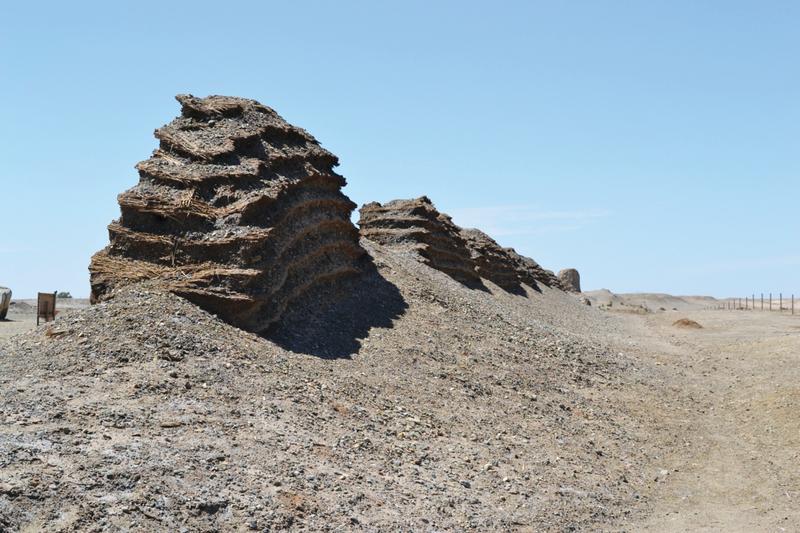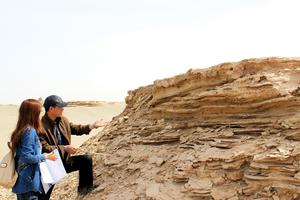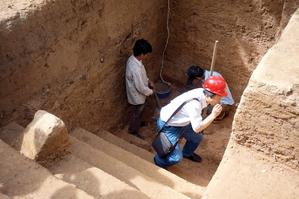Remote sensing technology is helping archaeologists unearth significant historical sites
 An ancient site that Wang Xinyuan’s team found in the Anxi-Dunhuang section of Gansu province on the route of the ancient Silk Road. (PHOTO PROVIDED TO CHINA DAILY)
An ancient site that Wang Xinyuan’s team found in the Anxi-Dunhuang section of Gansu province on the route of the ancient Silk Road. (PHOTO PROVIDED TO CHINA DAILY)
Often, when people think about space technology, they are looking outward — toward the stars and to worlds beyond our own. However, those same technical systems can also be used to improve knowledge of our own planet and civilization.
How exactly can space information technologies be applied to the research, monitoring and protection of cultural and natural heritage? Wang Xinyuan, deputy director of the International Center on Space Technologies for Natural and Cultural Heritage under the auspices of UNESCO, answered this question in an online lecture where he shared projects and discoveries.
The lecture was held by the center on June 13, China’s annual Cultural and Natural Heritage Day.
The center was opened in 2011 in Beijing. Hosted by Aerospace Information Research Institute at the Chinese Academy of Sciences, it is the first UNESCO category II center applying space technologies to the monitoring and conservation of the world’s natural and cultural heritage sites.
Wang shared how his team discovered ancient sites in Gansu province in 2013, and also led international teams to find 10 archaeological sites in Tunisia in 2018, using space information technology.
He said he hopes the online course will inspire more people to devote themselves to protecting the world’s cultural and natural heritage.
“It is not only the duty of professionals; the whole of society should also take responsibility,” Wang said. “We scientists have the duty to specify why, what and how to protect them to the public.”
Wang said that the study of world cultural and natural heritage is a comprehensive subject that requires multiple areas of expertise — from geology and geomorphology to paleontology — as well as the knowledge of how to protect and manage them.
Space archaeology is a new branch of archaeology with highly interdisciplinary attributes that link the natural sciences, sociology and humanities.
 Wang (right) and a team member on a field trip in the Xinjiang Uygur autonomous region. (PHOTO PROVIDED TO CHINA DAILY)
Wang (right) and a team member on a field trip in the Xinjiang Uygur autonomous region. (PHOTO PROVIDED TO CHINA DAILY)
As a specialist in this new field of study, Wang explained that the protection of cultural and natural sites also entails the protection of their surrounding environments.
“The task of space archaeology is to reveal the history, characteristics and patterns of human activities in the past, as well as to understand the evolutionary processes guiding the relationship between people and their environment,” he said.
Wang’s specialty, prior to taking up research in archaeological remote sensing, was geography and geology.
In 2013, Wang’s team found five ancient city sites, the remains of more than 10 houses in two residential villages, one ancient channel site, one ancient road site and one pottery kiln site in the Guazhou (Anxi)-Shazhou (Dunhuang) section of Gansu province along the major route of the ancient Silk Road.
This discovery, uncovered using remote sensing technology, which provides abundant physical materials for the study of the history and geography of China’s northwest frontier, fills the archaeological gap between sites from the Han Dynasty (206 BC-AD 220) and the Tang Dynasty (618-907) in the west of the ancient city of Bazhou.
“The sites of the places we discovered are in untraversed regions that are quite difficult for people to explore,” Wang said. Dry land, he added, is where remote sensing can be fully utilized, especially in places that are difficult to reach.
Wang’s team first did literature analysis — researching historical documents about the route before using remote sensing to pinpoint areas they suspected could yield results. They then worked together with researchers from local museums in Gansu to conduct on-the-spot investigations to verify each site.
“When you are on the ground, it can be difficult to ascertain whether the course of a river is natural or human made, but with the help of the sensors mounted on the space-borne platform, which provide a more macroscopic view, you can tell,” Wang said.
“The visual field of people is limited, but the emergence of remote sensing technology has given them a pair of eyes in space.”
The experience and success in Gansu gave Wang confidence to lead the research project in Tunisia. Inspired by one of Wang’s international students — a Tunisian — the project soon became one of international cooperation.
In 2018, Wang led a space archaeology research team, including scientists from Tunisia, Italy and Pakistan, to discover 10 ancient Roman archaeological sites in Tunisia. They were unearthed at the western end of the maritime Silk Road after two years of remote sensing image processing and field investigation.
 Wang (right) visits the world heritage site of Angkor Wat in Cambodia. (PHOTO PROVIDED TO CHINA DAILY)
Wang (right) visits the world heritage site of Angkor Wat in Cambodia. (PHOTO PROVIDED TO CHINA DAILY)
Tunisia was an important port for maritime trade under the Roman Empire. The archaeological sites they discovered are located in the Tunisian provinces of Gafsa, Tataouine and Medenine. The 10 sites include three sections of Rome Limes, two military fortifications, one agricultural irrigation system, three tanks and a burial site.
According to Wang, the discoveries are of great significance not only for the study of the empire’s military defense systems, agricultural irrigation systems and the relationship between nomadic nationalities and ancient Rome, but also changes in ancient oases and environmental evolution.
“The Lime wall and fortress were used to defend and protect the border and prevent the harassment by the nomads from the south and the west. Meanwhile, the agricultural irrigation system and the water tanks for storing fresh water were used to ensure grain production and serve the living needs of the border soldiers,” Wang said.
“It has a similar function to the Great Wall,” he added.
Wang’s team used high-resolution satellite remote sensing imagery to assess the suspected sites on the basis of historical information and ancient maps. It also employed a comprehensive geographic information system for spatial analysis.
In the following field verification process, a joint team of remote sensing experts and archaeologists conducted the survey and verification.
“The precise locations of the site were identified by using satellite remote sensing along with navigation and positioning systems,” he added.
It was the first time that a Chinese scientist had led such a project — one involving major countries in Asia, Europe and Africa — to discover foreign archaeological remains and conduct systematic research using space information technology in the field survey.
Bai Guangming, a cultural counselor at the Chinese embassy in Tunisia, said in a previous China Daily report that the country’s advanced remote sensing technologies will provide great scientific support and strengthen cultural exchanges among countries involved in the Belt and Road Initiative.
The project is funded by the Digital Belt and Road Program of the Chinese Academy of Sciences.
According to Wang, multiple international cooperation projects have been undertaken by his team. While the COVID-19 pandemic has delayed their plans for international field trips this year, the research and analysis work are still in full swing.


